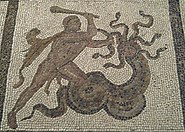
Back Teseus Afrikaans Teseu AN ثيسيوس Arabic Tesey Azerbaijani Тэсей Byelorussian Тезей Bulgarian থেসেউস Bengali/Bangla Theseüs Breton Tezej BS Teseu Catalan
| Theseus | |
|---|---|
 | |
| Abode | Elysium |
| Symbols | Sword, Corinthian Helmet (occasionally) |
| Festivals | Theseia |
| Personal information | |
| Born | |
| Died | |
| Parents | Aegeus and Aethra or Poseidon and Aethra |
| Consorts | Phaedra, Ariadne |
| Offspring | Demophon, Acamas |
| Part of a series on |
| Greek mythology |
|---|
 |
| Deities |
| Heroes and heroism |
| Related |
|
|
Theseus (UK: /ˈθiːsjuːs/, US: /ˈθiːsiəs/; Greek: Θησεύς [tʰɛːsěu̯s]) was a divine hero and the founder of Athens from Greek mythology. The myths surrounding Theseus, his journeys, exploits, and friends, have provided material for storytelling throughout the ages.
Theseus is sometimes described as the son of Aegeus, King of Athens, and sometimes as the son of the god Poseidon. He was raised by his mother, Aethra, and, upon discovering his connection to Aegeus, travels overland to Athens, having many adventures on the way. When he reaches Athens, he finds that Aegeus is married to Medea (formerly wife of Jason), who plots against him.
The most famous legend about Theseus is his slaying of the Minotaur, half man and half bull. He then goes on to unite Attica under Athenian rule: the synoikismos ('dwelling together'). As the unifying king, he is credited with building a palace on the fortress of the Acropolis. Pausanias reports that after synoikismos, Theseus established a cult of Aphrodite ('Aphrodite of all the People') on the southern slope of the Acropolis.
Plutarch's Life of Theseus makes use of varying accounts of the death of the Minotaur, Theseus's escape, and his romantic involvement with and betrayal of Ariadne, daughter of King Minos.[i]
Plutarch's avowed purpose is to construct a life that parallels the Life of Romulus, the founding myth of Rome. Plutarch's sources, not all of whose texts have survived independently, include Pherecydes (mid-fifth century BC), Demon (c. 400 BC), Philochorus, and Cleidemus (both fourth century BC).[1] As the subject of myth, the existence of Theseus as a real person has not been proven, but scholars believe that he may have been alive during the Late Bronze Age,[2] or possibly as a king in the 8th or 9th century BC.[3]
Cite error: There are <ref group=lower-roman> tags or {{efn-lr}} templates on this page, but the references will not show without a {{reflist|group=lower-roman}} template or {{notelist-lr}} template (see the help page).
- ^ Cueva, Edmund P. (1996). "Plutarch's Ariadne in Chariton's Chaereas and Callirhoe." American Journal of Philology, 117(3):473–84.
- ^ Greene, Andrew. "Theseus, Hero of Athens". Retrieved 25 November 2018.
- ^ Morford, Mark; Lenardon, Robert J.; Sham, Michael. "Classical Mythology Tenth Edition". Oxford University Press. Archived from the original on 10 November 2014. Retrieved 31 October 2016.
© MMXXIII Rich X Search. We shall prevail. All rights reserved. Rich X Search